Peter MALONE
Slim and I
SLIM AND I
Australia, 2020, 104 minutes, Colour.
Directed by Kriv Stenders.
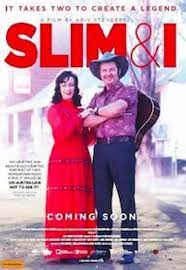 “The pub with no beer.”
“The pub with no beer.”
For those who have never heard of this song title, this documentary is a must, going back into Australia’s music history in the latter part of the 20th century, country music, folk music, songs as a voice for the rural community, songs as a bond between indigenous people and the latecomers to the land.
For those who recognise the title and associate it immediately with the singer, Slim Dusty, this will prove to be a very enjoyable documentary with more than a touch of nostalgia.
The writer-director of the film is Kriv Stenders, director of features, videos, documentaries and a number of feature films but, especially, the Red Dog films, two much loved films in Australia.
There was a feature film, The Slim Dusty Movie in 1984. This documentary draws on a number of sequences from this film, dramatising some of Slim Dusty’s early life and career.
However, while there is a portrait of Slim Dusty, very important is the I of the title. The I is his wife Joy McKean who is interviewed for this film, reminiscing, happy, sad, at the age of 90. In fact, this is very much a film about her, drawing on a memoir that she wrote, Slim and I, which is visualised, pages turning throughout this film. She is one of the two McKean sisters, Heather and Joy, the two interviewed for this film.
Joy was a prolific songwriter from an early age, then singing with her sister, performances, radio 2KY, well-known by the late 1940s and into the 1950s, the McKean sisters.
The film traces the relationship between Slim Dusty and Joy, meeting, singing, composing, performing, marrying, their two children, Anne and David, who are interviewed extensively throughout the film with many helpful memories explaining their parents. Anne was to join her parents in singing and tours.
There are also quite a number of impressive talking heads, singers and composers of country music from the past, their admiration for Slim Dusty and Joy, their songs, his performing them, the influence on their own careers. One of these is Chad Morgan, the well-known singer from the past with the protruding teeth! And, more contemporary, there are some comments from Missy Higgins and an interview with Keith Urban, and footage of him singing in performance with Slim Dusty. There are also interviews with music historians, talent promoters. They contribute well to the rounding of the picture of Slim Dusty.
And, the film also serves as something of an anthology of the many, many songs that he performed, and so many of them written by Joy. And, there is considerable footage from the past, of the family and their life, their different homes from Sydney to Metung, the extensive travel all around Australia over the years, their special presence at the local shows, the particular Western sideshow, characters, performances. And there is always Joy, and our being reminded sometimes of her disability, her calibre deadly and her limp. But, she emerges as the power behind the throne, skills in management and contracts, planning, and attention to all kinds of detail. And she has some moments, when she was pregnant with David, and two young blondes were employed for the performance and her warning Slim about his responsibilities to the family.
Slim was characterised by his hat, not recognised when he removed it! Loved singing, but he and Joy were ambitious and competitive, successful for many decades, and encouraging the upcoming generation. There is also talk of Slim Dusty’s restlessness, attempts to settle down, being in Sydney and record albums, his contract for many decades with EMI. But, he was always pleased to be on the road – and short tempered, suggestions that at times he had a rage.
In the middle of the documentary, there is a focus on Slim Dusty and Joy and their contact with indigenous peoples, their travels to the various towns, performances, their being well received and remembered, composing songs especially, Pepperminati, an invitation from teacher and later elderly Australian of the year, Miriam Rose Ungenmerr, inviting them to visit Daly River. The warmth with which the group was received by the indigenous communities, everybody joining in the singing, corrobberies performed for the guests, indicates how harmony can be achieved through music.
This is an important contribution to an appreciation of popular music in Australia, country and folk, the history of performance, Tamworth and other festivals, awards – and a satisfying experience of sitting and listening to Joy in her interviews, a wise woman reflecting at the age of 90.
Star Trek IV. The Voyage Home
STAR TREK IV, THE VOYAGE HOME
US, 1986, 119 minutes, Colour.
William Shatner, Leonard Nimoy, DeForest Kelley, James Doohan, George Takei, Walter Koenig, Nichelle Nichols, Jane Wyatt, Catherine Hicks, Mark Lenard, John Schuck, Brock Peters.
Directed by Leonard Nimoy.
 After its initial success of for television in the 1960s and 1970s, the Star Trek Franchise moved into cinema films in 1979. There followed another five films in the series, featuring William Shatner, Leonard Nimoy and the popular characters from the television series.
After its initial success of for television in the 1960s and 1970s, the Star Trek Franchise moved into cinema films in 1979. There followed another five films in the series, featuring William Shatner, Leonard Nimoy and the popular characters from the television series.
In retrospect, this particular contribution seems rather anomalous, most of the action taking place in San Francisco in the present. While the film opens with action in outer space and moves towards the finale in space and the future, the attention is given to disruption with some planets, questions of signals, indicating humpback whales although the screenplay posits that they have become extinct.
James T.Kirk, now addressed as Admiral, undertakes an expedition through time walk to come back to the 1980s to find two humpback whales and transport them to the future and to restore order in the galaxies. The film was directed by Leonard Nimoy who is prominent, as usual, as Spock, a meeting with his mother (veteran actress Jane Wyatt) and later with his Senator father. He is taunted, especially by Bones, about his being half human but his relying always on logic, but an appeal made to him about saving one while endangering the others.
Spock is able to provide all the technical details needed for this journey. There is quite some comedy in experts from the future trying to find their way in 1980s San Francisco, issues of money, directions, thinking that knowledge of the time was rather primitive, jokes about time travel, asking directions for Nuclear Weapons, stealing energy from the Navy, and Kirk and Spock not having enough exact change to take the bus! Also a comment on language of the times!
Catherine Hicks plays Alice, a whale biologist who is suspicious of the behaviour of Spock as he swims with the whales, discovering that one is pregnant. However, as might be expected, she is eventually won over with the threat of the whales been released in the oceans and becoming the prey of whalers. The film shows the technology of beaming up the whales from the sea into the space vehicle and then the aquarium in the future.
The film feels very much at the time, had several technical Oscar nominations, audiences liking the visit to the present and the touches of humour.
Greenhouse, The
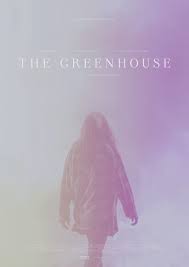
THE GREENHOUSE
Australia, 2021, 97 minutes, Colour.
Jane Watt, Joel Horwood, Kirsty Marillier, Shiv Palekar, Rhondda Findleton, Camilla Ah Kim, Harriet Gordon-Anderson.
Directed by Thomas Wilson-White.
This is a small budget film, written and directed by Thomas Wilson White who had made short films. He draws on his own life experience for the story, especially his growing up with two mothers.
However, the central character of this film is one of the daughters, one of three adopted children. While the film is set in the present, there are various flashbacks. However, the film also moves into some magical realism, time travel into the past, Beth discovering a greenhouse and this being the portal to her going back, later the search for one of the mothers and her siblings joining her in the greenhouse and venturing back into the past, surfacing difficulties, possibilities for reconciliation.
Jane Watt portrays Beth, the central character, sad at the death of one of the mothers, Rhondda Findlayson, and staying in the family home, bereavement, longtime grieving, eventually antagonism with her siblings. However, they are assembled for the other mother’s 60th birthday, the celebration, yet more antagonism and the others leaving, only for Beth to find that their mother has disappeared and she phones them to bring them back.
The culmination of the film is going into the greenhouse, going into the past, reliving as they observe episodes from the past, the dead mother not recognising them, the other mother making an option to stay with her partner – and the others having to make the effort to come back to reality, to the present, some kind of reconciliation including Beth bonding again with a love from the past.
The film was screened at many Queer Film Festivals and won a number of awards.
- The title, realism, magical realism, fantasy, time travel?
- The Australian setting, New South Wales South Coast, the home, the grounds, the atmosphere? The musical score?
- The structure of the film, the present, the flashbacks, journey to the past, observing the past, intervening?
- The focus on the family, the two mums, happiness in the household, the adoption of the children, their growing up, bonds with the mothers, bonds with each other? Scenes of happy meals?
- The focus on Beth, her place amongst the three, relationship with the mothers, the death, her grief, the long time of grief and its effect on her, staying with the other mother? Alienation from the siblings? The portrait of Beth, grief, in the present, Lauren visiting the town, Beth hiding, fear, their meeting and embrace? The revelation of the past experience, family reactions? Beth and her separation?
- Beth, the greenhouse, its interiors, atmosphere, moving out of the greenhouse, the venturing into the past? Her experiences, her dead mother?
- The 60th birthday, the party, everyone assembling, the speech and the toast, the three amongst themselves, their characters, subsequent careers and leaving home, doctor, actor, antagonisms? Especially towards Beth?
- The day after, Beth discovering the note, the disappearance of the mother, the conflict with the siblings, the fights, especially Drew? Yet memories of their being friends in their childhood? Their leaving, Beth and the phone call, the return?
- Venturing out, the greenhouse, the fog, the car and the space in the boot, emerging in the alternate world, the encounter with their dead mother, her not recognising them? The search, in the water, finding their mother in the greenhouse?
- The siblings, seeing the past, the ghostly figures, the hostile ghostly figures? Lauren appearing? The mother deciding to stay with her partner, the farewell?
- The experience is a kind of exorcism of the past, the bonding between the siblings, Lauren and her bonding with Beth? Beth being able to move away?
Beware the Slenderman
BEWARE THE SLENDERMAN
US, 2016, 114 minutes, Colour.
Directed by Irene Taylor.
 The brief synopsis states: Tells the story of two 12-year old girls, who attempted to murder one of their friends in an attempt to appease Slenderman, a fictional monster from a horror website.
The brief synopsis states: Tells the story of two 12-year old girls, who attempted to murder one of their friends in an attempt to appease Slenderman, a fictional monster from a horror website.
However, this documentary is far more complex. It is in the vein of many documentaries during the 2010 is and beyond, the filmmakers gathering audio and visual interviews and making them available within the context of the investigation. This is happened with a number of American documentaries about criminals like those of Joe Bellinger on Ted Bundy and John Wayne Gacy.
Filming about this case began not long after the actual events, the arrest of two 12 year old girls, the interrogations of the girls, legal, psychological. There are also interviews with the parents of each of the two girls, gradually revealing the situations within the house, the fact that one of the girls, the leader, experienced psychological difficulties from an early age, and its being revealed that the father also had psychological difficulties. With the other family, the initial focus is on the mother, creating the picture of the household, later introducing the perspective of the father.
The victim survived, no interviews in the film with her but commentary about her and the response of her parents.
There have been a number of films about child killers, especially the classic original and remake of The Bad Seed, as well as documentaries about prominent cases as in the UK, the Bolger case.
What makes this documentary different is the focus on the motivation of the two girls. The had been watching social media and become very much aware of The Slenderman, and horror stories about his ominous presence, influence, control, the need to be appeased. The girls had absorbed this social media mythology (which began about 2010). Which meant then that they chose their victim, even though she was their friend, took her aside, one of them with a knife, many stab wounds, the girls leaving her but yet regretting that they had had to attack their friend, but these were the demands of the Slenderman.
Which raises questions then about the influence of social media on children. Questions are also raised about psychological conditions and their consequences, moral consequences and, with the girls, legal consequences with rather strict interpretation by the presiding judge.
Provocative and interesting, somewhat morbid, American documentary.
Adam Project, The
THE ADAM PROJECT
US, 2022, 104 minutes, Colour.
Ryan Reynolds, Walker Scobell, Mark Ruffalo, Jennifer Garner, Zoe Saldana, Catherine Keener.
Directed by Shawn Levy.
 Here is science-fiction, science-fantasy for a younger audience. In fact, it is also an entertainment for adults. And this is the intention of the filmmakers, having two characters, two Addams – or, rather, the younger Adam an older Adam. The older Adam is played genially by Ryan Reynolds in his familiar affable style. The younger Adam is played by Walker Scobel.
Here is science-fiction, science-fantasy for a younger audience. In fact, it is also an entertainment for adults. And this is the intention of the filmmakers, having two characters, two Addams – or, rather, the younger Adam an older Adam. The older Adam is played genially by Ryan Reynolds in his familiar affable style. The younger Adam is played by Walker Scobel.
The film is set in 2050 as well is in 2022. The screenplay depends on the effect of time travel, taking it for granted, but making some audiences wonder whether it it is at all possible (and, if it is, what are the possibilities!). However, all is not happy in 2050.
With the young Adam the focus of the story, we see him at school, asthmatic, bullied, in a difficult relationship with his mother (Jennifer Garner) because of the recent death of his scientist father (Mark Ruffalo). In the meantime, we see the older Adam stealing are playing in order to find his wife who has been lost in time travel, Laura (Zoe Saldana). However, he crash lands in 2022 instead of his intended target of 2018.
Audiences with a technological bent will enjoy the picture of laboratories, technology, scientific advances, algorithms and speculation as well as vehicles from the future.
And, for the action, there is an arch-villain, Maya Sorian, played by Catherine Keener who has an arch-villain enforcer, Christos. The audience sees her place in the developments in 2018, the death of the scientist, her taking over control of algorithms in time travel, becoming a dictator in the future.
There are complicated enjoyable twists, Laura appearing, her relationship with her husband, the issue of meeting him again in 2018, her helping him in his quest. There is also the introduction of Louis and seeing his work and his wanting to destroy the time travel algorithm. And, in the future, there are some spectacular chases and fights in the laboratories.
Direction is by Shawn Levy, best known for many comedies including the remakes of Cheaper by the Dozen, at the Pink Panther, the Night at the Museum series.
- The title? The significance of Adam, the generic name for the male? Biblical tones?
- 2050, the technology, the lifestyle, the technology, laboratories, time travel, power and dictatorship, violence and vengeance? The musical score?
- The contrast with 2022, ordinary, homes, school and bullying, science and technology? The musical score?
- Adam, 2050, the presence of Ryan Reynolds, his role as a pilot, the decision to steal the plane, to find his wife, Laura, again? Her disappearance in 2018? Stealing the plane, the travel, the crash, 2022, his injuries?
- 2022, the young Adam, his age, interests, asthma, at school, bullied? Depressed about his father’s death? The tension with his mother? His finding the injured Adam?
- Issues of time travel, the possibility or not, possibilities for imagining time travel?
- The future, Maya, Christos her associate, in command, power, vengeful? Confronting Laura, Laura disappearing, faking her death?
- The past, Louis, his technology, the algorithms, time travel? His relationship with his wife and son? Busy with the technology? Maya, the businesswoman, working with him? His death in the car accident? Maya taking over, exploiting Louis’ work?
- 2018, Louis, his work, the appearance of the two Adams, time streaming the effect, decisions, to destroy the algorithm, to destroy time travel?
- The two Adams, working together, sharing memories, bonding, the motel?
- The consequences for the future, 2050, Maher, her ruthlessness, to destroy the older Adam, taking the younger Adam, his injuries? The issues of the algorithms?
- The struggle, the young Adam, confronting Maya, the spectacular technological chases? Maya, her being killed, her younger self, so disappearing?
- The restoration of order, Adam and Laura reunited, the young Adam, bonding with his mother?
- An entertaining science-fiction, science-fantasy for younger audiences?
Endless/ US
ENDLESS
US, 2020, 95 minutes, Colour.
Alexandra Shipp, Nicholas Hamilton, DeRon Horton, Ian Tracy, Catherine Haggquist, Eddie Ramos, Famke Janssen, Aaron Pearl.
Directed by Scott Speer.
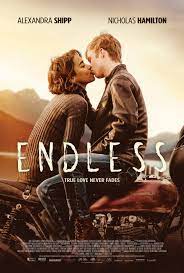 Endless is the Young Adult story, but especially appealing to teenage audiences who can identify with the central characters.
Endless is the Young Adult story, but especially appealing to teenage audiences who can identify with the central characters.
This is a variation on a ghost story, reminiscent of the romance in the classic 1990s Ghost.
Alexandra Shipp and Nicholas Hamilton play two young adult, in love, involved in a car crash where Chris, Nicholas Hamilton, is killed. Riley, Alexandra Shipp, blames herself. She is consumed by grief, adults with her parents wanting her to give up art and pursued law. There are two friends from school as well as the involvement of Chris’s mother.
Where the film is different is that Chris goes to a kind of limbo, meets another dead man, a guide, who explains his situation. He is able to communicate with Riley, she able to hear him. However, while this is a love story, it is also a story of having to let go.
Director, Scott Speer, made a very interesting variation on a ghost story, crime story, I See You.
- Young adult story? The appeal to younger audiences, teenagers?
- The American town, homes, studies, the countryside and roads? The musical score?
- Riley and Chris, ages, the family backgrounds, Riley and art, her parents expectations, the law? Chris, his mother, absent father? The relationship between the two?
- The accident, Chris’s death, Riley blaming herself, the detective and the enquiry, the car, the lights? Blame and guilt? The consequences for Riley and Chris’s absence?
- Chris, his death, going into a kind of limbo, the encounter with Jordan, Jordan’s personality, explaining the situation to Chris? Making contact with Riley, his presence, her hearing him? The bonding?
- Riley and her friends, their characters, support, her finding her way?
- Grief, blame, ghostly possibilities, love, the title of the film, yet letting go?
Star Trek V. The Final Frontier
STAR TREK V, THE FINAL FRONTIER
US, 1989, 105 minutes, Colour.
William Shatner, Leonard Nimoy, DeForest Kelley, James Doohan, George Takei, Walter Koenig, Nichelle Nichols, David Warner, Laurence Luckinbill, Charles Cooper.
Directed by William Shatner.
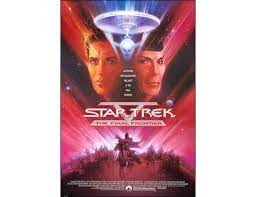 After its initial success of for television in the 1960s and 1970s, the Star Trek Franchise moved into cinema films in 1979. There followed another five films in the series, featuring William Shatner, Leonard Nimoy and the popular characters from the television series.
After its initial success of for television in the 1960s and 1970s, the Star Trek Franchise moved into cinema films in 1979. There followed another five films in the series, featuring William Shatner, Leonard Nimoy and the popular characters from the television series.
The fourth episode was directed by Leonard Nimoy. This time it is the turn of William Shatner. And this time, most of the action takes place in the future and in the universe – with some time off for Earth sequences, especially Kirk mountain climbing but rescued by Spock, camping out with Bones and Spock, Spock trying to learn the human ways of camping and, especially, though he is able to quote poetry and give authors in verse references, he does not know Row, Row, Row, Your Boat – but learns it by the finale!
The film opens in the desert, warriors, an attack on a club, The Paradise (which has a kind of mutant pole dancer). Then three characters are captured as ransom. David Warner appears as the human character. However, the focus is on Laurence Luckinbill as a Vulcan, who is a crusader, but has a religious urge, wanting to control Kirk and his crew (who do attack the club and there are some battles but this is not what the Vulcan wants, preferring peace, and controlling the emotions of the crew). He is also seeking God, urging Kirk to travel to a mysterious barrier in which he finds God, but a God who feels that he has been imprisoned, who is vengeful, who demands the life of the Vulcan that the others might be free. And then the Vulcan, confronting the God, finds it is his vengeful self and surrenders himself to the God.
A key aspect of the plot is that the Vulcan turns out to be the half brother of Spock, Spock unwilling to support his fellow Vulcan, unable to kill him at Kirk’s command. Bones, always taunting Spock about his lack of humanity, is amazed at Spock’s behaviour towards his half-brother.
The film, as with the series, gives prominence to the regular members of the cast and the Enterprise crew, with some late beaming up by Scotty.
The series was becoming more familiar but also moving towards its end.
Interceptor
INTERCEPTOR
Australia/US, 2022, 99 minutes, Colour.
Elsa Pataky, Luke Bracey, Aaron Glenane, Mayen Mehta, Paul Caesar, Marcus Johnson, Zoe Carides, Chris Hemsworth.
Directed by Matthew Reilly.
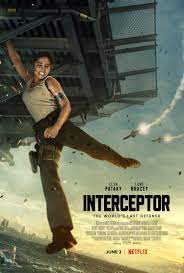 In the old days, single hero exploits could be referred to as a “one-man band”. Interceptor is definitely the era of the “one-woman band”. This show is definitely for the action fans, the kinds of exploits we have seen in the past (as with Jean Claude van Damme, Steven Seagal as one-man bands), lots of action, lots of threats, lots of suspense, lots of last-minute – or, rather here, last-second – saving of the planet.
In the old days, single hero exploits could be referred to as a “one-man band”. Interceptor is definitely the era of the “one-woman band”. This show is definitely for the action fans, the kinds of exploits we have seen in the past (as with Jean Claude van Damme, Steven Seagal as one-man bands), lots of action, lots of threats, lots of suspense, lots of last-minute – or, rather here, last-second – saving of the planet.
The film was written and directed by Matthew Reilly, a novelist for many years, this his first feature film, collaborating with popular writer Stuart Beattie. It is an Australian-US production, filmed in Sydney.
And the one-woman band, JJ, without any benefit of super-powers, is played by Elsa Pataky, who has appeared in the number of films but has tended to stay home bringing up her children with her husband, the executive producer of this film – and, comically playing a kind of Los Angeles “dude” selling televisions, Chris Hemsworth.
Matthew Reilly has created a dire world situation, and disillusioned with the US gangs stealing 16 nuclear weapons in Russia. They are mainly disaffected Americans, led by a seemingly charming psychopath played by Luke Bracey. His team have infiltrated one of the two interceptor-of-nuclear-missiles centres in Alaska. The other is a floating centre in the Pacific. JJ has experienced some sexual harassment by a top general in the past and he has been believed rather than she. Topical material and she has suffered for it. And she has been appointed to this floating centre. Almost immediately, it is attacked by the subversive team. So, suspense level raised early, how will she manage, presumption being that she will manage, with so much stacked against her.
Elsa Pataky as warrior is not strong on charm and personality. She is military, businesslike, loyal. And she has the backing of her father seen in a number of flashbacks (Colin Friel looking the worse for age and wear). She does have a loyal corporal technician, a married man with children, rather timid, but he does prove himself in courage. Otherwise, she has to rely on the moral support of the television link to the White House, to the President (Zoe Carides) and to the generals and their encouragement.
And, that is what happens. But, there is the psychological confrontation between the leader and JJ, each trying to use their wits but having to fall back on physical conflict. And there are quite a number of fights!
The tension is very strong because one of the missiles, aimed at an American city, with the rebels taking charge of television channels and threatening the US public, needs to be stopped by JJ who has been captured, hands bound behind her back. She has about six minutes of leeway. But, with that crisis out of the way, the other 15 nuclear missiles have been launched. How can JJ possibly press the interceptor button when she has been in the ocean, climbing steep rungs, having to leap from supporting bars to another, the clock ticking down?
It is no spoiler to say that she succeeds. That’s what we expect. The action adventure is in the audience identifying with JJ and the challenges and suspense in her trying to save the world.
Monte Verita
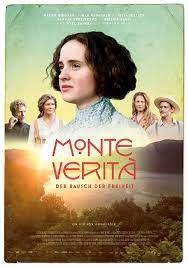
Path, The/ Der Pfad
THE PATH/ DER PFAD
Germany, 2022, 95 minutes, Colour.
Julius Weckauf, Nonna Cardoner, Volker Bruch, David Bredin.
Directed by Tobias Widemann.
 Quite different is The Path, opening in Marseilles 1940, a journalist fleeing Germany with his young son, trying to escape with false papers to join his wife in New York. The focus is on the young boy, possessive of his dog and smuggling it through the Pyrenees, dangers for his father and himself and the young girl who is their guide. For most of the film, the boy has to learn his responsibilities, accept blame for the situation he finds himself in, but also some moments of goodness and happiness.
Quite different is The Path, opening in Marseilles 1940, a journalist fleeing Germany with his young son, trying to escape with false papers to join his wife in New York. The focus is on the young boy, possessive of his dog and smuggling it through the Pyrenees, dangers for his father and himself and the young girl who is their guide. For most of the film, the boy has to learn his responsibilities, accept blame for the situation he finds himself in, but also some moments of goodness and happiness.
- World War II? In occupied France? Free France? Spain, the Pyrenees? Refugees to the US?
- The situation with the family, the father, journalist, antagonising the Nazis, fleeing Germany? His wife and her visit to the US, staying there? Correspondence? Their son, his age, his attachment to his dog, promises to his mother? The need for documents?
- Marseilles, father and son unable to sail to the US, the arrangements for the documents, the train trip to the Pyrenees? Dangers?
- The father, his contacts, his son, atmosphere of innocence?
- The contact at the Pyrenees, the family, money issues, advice, the track in the mountains, the issue of the dog, Rolf and his attachment, promises? The alcohol, the dog losing consciousness, packed in the bag?
- The guide, her age, experience, issues of trust?
- The trek, several hours over the mountains, glimpses of the sea, the status of Spain, neutral, German presence and soldiers? The difficulties of the trek, the discovery of the dog? The reactions? Held up by the soldiers, the father giving himself up to save his son?
- The trek with the boy and the girl, mutual distrust, getting to know each other, her exasperation, the issue of responsibility, her getting him to admit his responsibility?
- The dangers of the walk, Germans and soldiers, going to the other village, Rolf and his wanting to find his father?
- The meeting with the partisans, their care, the news of the guide’s parents, going to the prison, the importance of the diamond, his father giving it to Rolf, to pay for the fares, the drama of the splitting of the diamond and the success, paying for the release of the guide’s parents?
- The dangers, the fighting, the role of the dog, appearing and disappearing?
- The partisans, their friendliness, the dangers for themselves, the fighting?
- The farewell, the guide with her parents? Rolf and his sailing to America, the story of his mother meeting of remote, his being interrogated by customs, reunited with his mother?